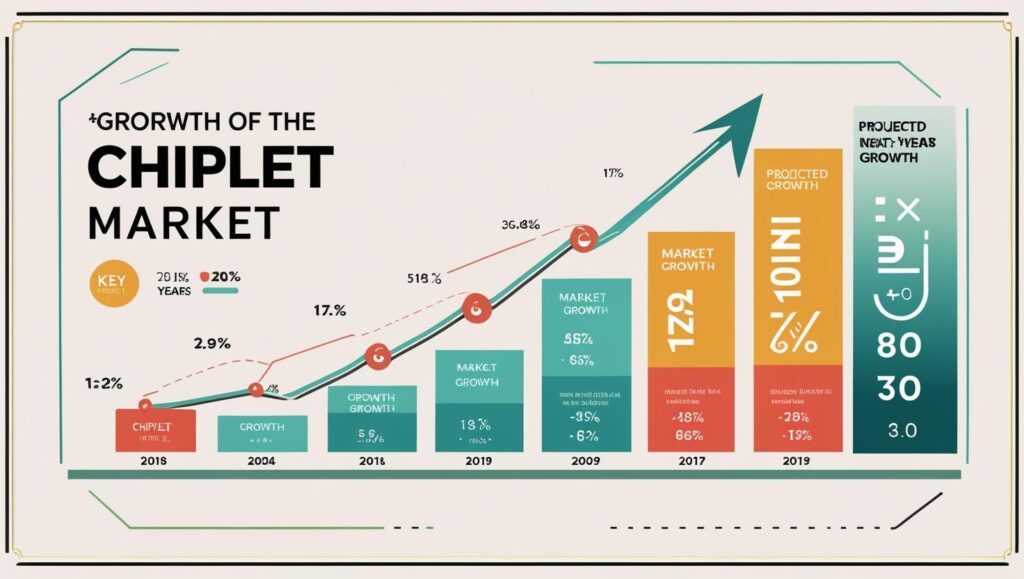In the ever-evolving semiconductor landscape, the chiplet architecture has emerged as a transformative force, redefining how chips are designed, manufactured, and scaled. Once bound by the limitations of monolithic silicon designs and the slowing of Moore’s Law, the industry is now turning to modular innovation—powered by chiplets—to achieve greater performance, flexibility, and cost-efficiency.
As demand for high-performance computing (HPC), AI, 5G, and advanced edge devices continues to surge, the chiplet market is experiencing accelerated growth, with massive implications for technology companies, chipmakers, system architects, and the entire global supply chain.
What Are Chiplets?
Chiplets are modular, functional blocks that can be combined on a single substrate or package to form a complete system-on-chip (SoC) or system-in-package (SiP). Rather than building an entire chip as a monolithic piece of silicon—which becomes increasingly expensive and complex at advanced nodes—chiplets enable engineers to partition different functions (e.g., CPU cores, GPUs, memory, I/O) into smaller, reusable silicon blocks.
These modular components are then interconnected using advanced packaging technologies, such as 2.5D interposers, 3D stacking, or emerging standards like UCIe (Universal Chiplet Interconnect Express), enabling high-bandwidth, low-latency communication between the blocks.
Why Chiplets Are Gaining Momentum
The rise of chiplets is largely driven by the diminishing returns of traditional scaling. As transistor sizes shrink below 5nm, the cost per transistor is no longer falling as it did in past generations. Yields are lower, development costs are higher, and design complexity skyrockets. Chiplets provide a path forward by decoupling design complexity and enabling IP reuse, faster time-to-market, and better manufacturing yields.
In addition, chiplets allow for heterogeneous integration—the ability to mix and match different process nodes, technologies, or even silicon from different vendors. This opens the door for customized, application-specific architectures that combine logic, memory, RF, and AI accelerators in a single package.
Download PDF Brochure @ https://www.marketsandmarkets.com/pdfdownloadNew.asp?id=131809383

Key Growth Drivers in the Chiplet Market
1. High-Performance Computing (HPC) and Data Centers
Leading hyperscalers and chip companies are adopting chiplet-based architectures to increase core counts, memory bandwidth, and compute density. AMD’s EPYC processors and Intel’s Foveros packaging are prime examples of how chiplets enable scalable, high-performance CPUs.
2. AI and Machine Learning Workloads
As AI models become larger and more complex, chiplets allow designers to integrate specialized AI accelerators alongside traditional compute units, optimizing both performance and energy efficiency.
3. Advanced Packaging Innovations
The growth of the chiplet market is closely tied to progress in packaging technologies. Solutions like Intel’s EMIB, TSMC’s CoWoS, and Samsung’s I-Cube are enabling tighter integration, higher I/O bandwidth, and more efficient power delivery between chiplets.
4. Industry Standards and Ecosystem Collaboration
With initiatives like the UCIe Consortium, the industry is moving toward standardized interconnects for chiplets. This could pave the way for an open ecosystem, allowing companies to source best-in-class chiplets from different vendors—much like components in the PC era.
Market Outlook and Investment Landscape
The global chiplet market size was valued at USD 6.5 billion in 2023 and is estimated to reach USD 148.0 billion by 2028, growing a CAGR of 86.7% during the forecast period. driven by demand from AI, 5G, cloud computing, automotive electronics, and next-generation consumer devices.
In parallel, EDA companies are evolving their tools to support multi-die design, thermal analysis, and co-optimization of architecture, packaging, and power—a critical enabler for the chiplet revolution.
Challenges and Roadblocks
While the potential is vast, several challenges remain. Designing chiplets introduces new complexities in power management, thermal control, latency, yield variability, and die-to-die communication. Testing and validation of chiplet-based systems also require new methodologies. Moreover, without mature standards and open interoperability, the chiplet ecosystem risks fragmentation.
Security is another concern. Modular systems increase the attack surface and raise questions about supply chain integrity and hardware-level vulnerabilities. These issues must be addressed as adoption scales.
Major vendors in the chiplet companies include
- Intel Corporation (US),
- Advanced Micro Devices, Inc. (US),
- Apple Inc. (US),
- IBM (US),
- Marvell (US),
- MediaTek Inc. (Taiwan),
- NVIDIA Corporation (us),
- Achronix Semiconductor Corporation (US),
- Ranovus (Canada), and ASE Technology Holding Co., Ltd. (Taiwan). Apart from this,
- Netronome (US),
- Cadence Design Systems, Inc. (US), and Synopsys, Inc. (US),
- SiFive, Inc. (US),
- ALPHAWAVE SEMI (UK),
- Eliyan (US),
- Ayar Labs, Inc. (US),
Conclusion: A New Paradigm in Silicon Innovation
The transition to chiplet-based design represents a paradigm shift in semiconductor development. By embracing modularity, flexibility, and heterogeneous integration, chiplets are unlocking new levels of scalability, customization, and performance—just as traditional scaling approaches hit a wall.
As innovation in packaging, AI, and system architecture converges, the chiplet market is positioned to become a cornerstone of next-generation computing. For companies across the semiconductor value chain, embracing this shift is not just an opportunity—it’s a strategic imperative.
The era of the modular silicon economy is here—and it’s accelerating fast.
FAQ
Why should investors pay attention to the chiplet market?
The chiplet market represents a disruptive shift in semiconductor design, offering a solution to the limitations of traditional monolithic chips. It opens new revenue streams by enabling modular, scalable, and cost-effective chip production—crucial for future tech like AI, 5G, and HPC.
What is the market size and growth potential?
The global chiplet market size was valued at USD 6.5 billion in 2023 and is estimated to reach USD 148.0 billion by 2028, growing a CAGR of 86.7% during the forecast period. This growth is fueled by demand from data centers, AI workloads, telecom infrastructure, automotive, and consumer electronics.
What are the key investment opportunities within the chiplet ecosystem?
Investors can target:
- Semiconductor companies developing chiplet-enabled processors and accelerators (e.g., AMD, Intel)
- Advanced packaging and substrate manufacturers (e.g., TSMC, Amkor)
- EDA tool providers focusing on multi-die design and verification
- IP and design firms specializing in chiplet interfaces and reusable blocks
- Standards consortia and startups enabling chiplet interoperability